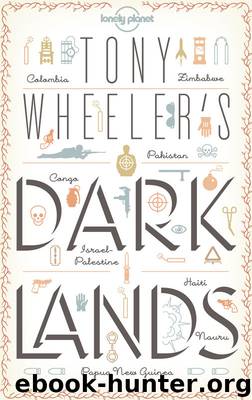Tony Wheeler's Dark Lands1 (Lonely Planet Travel Literature) by Wheeler Tony

Author:Wheeler, Tony [Wheeler, Tony]
Language: eng
Format: epub
Publisher: Lonely Planet Publications
Published: 2013-08-31T18:30:00+00:00
Nauru’s bird-shit wealth took a century to spend, but millennia to build up. It all comes down to the island’s remote location. You have to head 300 kilometres east to reach Nauru’s nearest neighbour, Ocean Island, also known as Banaba. Part of the Pacific nation of Kiribati, but a long way from all the other islands in that scattered group, Ocean Island is in fact just Nauru II. It’s only a third of the size of Nauru and was also, once upon a time, one big heap of bird shit. Just like Nauru, it’s been totally mined out.
Ocean Island aside, you have to travel nearly 700 kilometres east to reach the main islands of the Kiribati group, and over 1000 kilometres south-west to the Solomons. It’s no wonder a bird was up for some R&R by the time it reached Nauru. The island still attracts regular avian visitors, it’s just that mining the guano also took the trees and until some vegetation returns the birds won’t be arriving in the vast numbers needed to recreate the island in a few more millennia.
Birdwatchers can still find twenty-seven different bird species on Nauru, most of them seabirds like Audubon’s shearwater; Red-tailed and White-tailed Tropicbirds, with their long trailing tail feathers; the brown booby; the great frigatebird, which can stay aloft for more than a week at a time; and five different types of terns. There’s even an endemic species, found only on Nauru. At least, at the moment – the Nauru reed-warbler is an endangered species. It lives in shrubland, which has pretty much disappeared along with everything else on the island – the guano, the tree cover and the seabirds that provided the guano and needed the tree cover for shelter during their island stopovers.
To get a feel for what Nauru must have been like in its heyday, pay a visit to Heron Island on Australia’s Great Barrier Reef. It’s densely covered with trees and, in season, is equally dense with Black Noddy Terns, the same species that call in on Nauru, and wedge-tailed shearwaters. The sheer density of birdlife on Heron Island can be stunning, ditto for the sheer volume of the noise. This isn’t likely across most of Nauru now. There’s a thin fringe of trees around the coastline, but the dense forest that once carpeted the whole island is gone. The spiky stone columns of Topside don’t attract migrating birdlife.
Humans came along much later than the birds, but they’ve been on the island for at least 3000 years. Like other Pacific islanders, their diet featured lots of coconuts and pandanus fruit, but they also practised fish farming in the Buada Lagoon. A British seafarer stopped by Nauru in 1798 and dubbed it Pleasant Island, but very soon things weren’t so pleasant. From 1830 traders and whalers started to turn up, some of them taking residence on the island, bringing alcohol and firearms with them. Eventually petty squabbles degenerated into the Nauruan Tribal War and in the ten years from 1878 the population of the island fell from 1400 to 900 people.
Download
This site does not store any files on its server. We only index and link to content provided by other sites. Please contact the content providers to delete copyright contents if any and email us, we'll remove relevant links or contents immediately.
How to Read Water: Clues and Patterns from Puddles to the Sea (Natural Navigation) by Tristan Gooley(3380)
Full Circle by Michael Palin(3359)
Into Thin Air by Jon Krakauer(3282)
How to Read Nature by Tristan Gooley(3221)
In Patagonia by Bruce Chatwin(2846)
The Lost Art of Reading Nature's Signs by Tristan Gooley(2593)
A Thousand Splendid Suns by Khaled Hosseini(2591)
Don't Sleep, There Are Snakes by Daniel L. Everett(2536)
Venice by Jan Morris(2505)
City of Djinns: a year in Delhi by William Dalrymple(2493)
The Songlines by Bruce Chatwin(2482)
L'Appart by David Lebovitz(2454)
The Queen of Nothing by Holly Black(2452)
The Big Twitch by Sean Dooley(2372)
Tokyo Geek's Guide: Manga, Anime, Gaming, Cosplay, Toys, Idols & More - The Ultimate Guide to Japan's Otaku Culture by Simone Gianni(2300)
Iranian Rappers And Persian Porn by Maslin Jamie(2143)
INTO THE WILD by Jon Krakauer(2138)
A TIME OF GIFTS by Patrick Leigh Fermor(2138)
Come, Tell Me How You Live by Mallowan Agatha Christie(2106)
